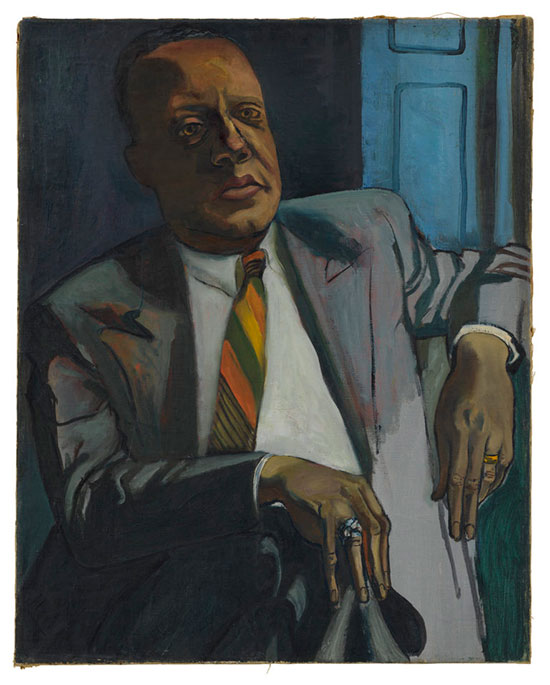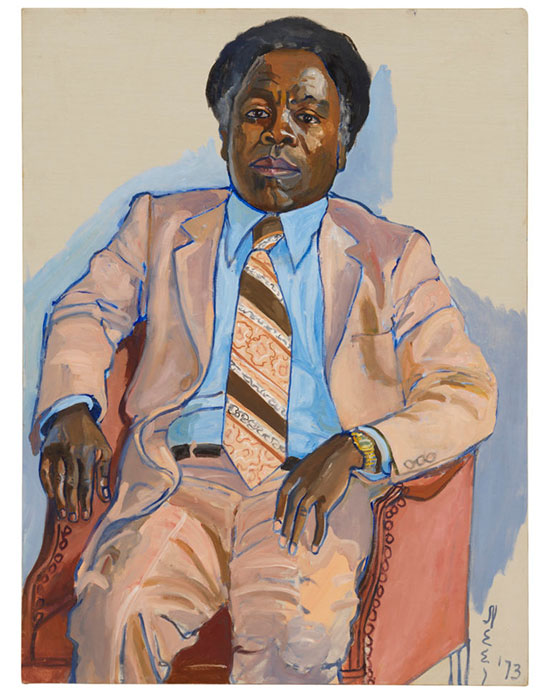“Alice Neel: Uptown,” an exhibit of 26 paintings and six drawings on view through April 22, 2017 at David Zwirner, adds to the growing number of exhibitions, books and papers devoted to a painter whose work took 40 years to gain recognition. Selected by critic Hilton Als, the works that comprise the “Uptown”show are portraits of friends, acquaintances and local residents Neel knew personally, or had some contact with during her long years living in East Harlem and later on the West Side at the same Upper Manhattan latitude.
Though the show’s biographical parameters are set by Neel’s distance from the art scene and, later, from her downtown contemporaries, the work itself sheds a welcome light on aspects of her development from 1943, the earliest piece in the show, to 1978, six years before her passing. This survey reveals the artist to be, in spite of her isolation, very much in tune with the times.
Neel was never really disconnected from cultural life of New York, as demonstrated in the show by the inclusion of canvases representing actor Alice Childress and writer Harold Cruse, both dated 1950. Yet it’s clear that most of her effort went to portraits of handymen, children, taxi drivers, mothers with their babies—basically her neighbors. Nevertheless, Neel’s relative isolation consisted of several real barriers.
.

"Alice Childress" by Alice Neel, 1950. Oil on canvas, 30 1/8 x 20 1/8 inches. Collection of Art Berliner. © The Estate of Alice Neel. Courtesy David Zwirner, New York/London and Victoria Miro, London.
.

"Harold Cruse" by Alice Neel, 1950. Oil on canvas, 37 x 22 inches. © The Estate of Alice Neel. Courtesy David Zwirner, New York/London and Victoria Miro, London.
.
Committing to a genre clearly at odds with the period’s heroic abstraction was certainly one such barrier. Another was not just her location but the direction one travelled to get there. In the late 1950s, Soho lofts were seven subway stops south of MoMA. Neel, too, was seven stops from MoMA. But these stops ran north to the wrong side of 96th street, the hard demarcation between the silk stocking district and East Harlem, known locally as El Barrio. (For all the weight El Barrio’s citizens carried in the art world, Neel might as well have been across the river in the Bronx.) *
Neel lived for 25 years in East Harlem. The West Side space she moved into in 1962 was larger and sunnier, providing adequate natural light for most of the day. The effect of this can be seen in how the artist’s color brightened and held to its intensity by her leaving the white ground exposed in the final painting, or lightly washed in a pale blue. It is important to note that, by 1962, the art world was quickly absorbing the early waves of Pop art and Color Field painting, both of which set the fashion compass to intense and unadulterated color. In this sense, Neel proves attentive to the zeitgeist. She may have seemed peripheral, but she was apparently paying attention.
Als’s selection shows Neel at her best, which takes quite a lot of selecting. Neel is like a novelist whose editor must tear reams of pages from the manuscript to get at the treasure within. Her habitual use of devices absorbed from early modernism seemed to have slowed her development as a portrait painter, particularly a painter favoring a sympathetic perspective toward her sitters. Style and substance often clashed. For instance, her habit of painting a dark outline below, as well as above the eye—perhaps a holdover from Picasso—often led to flat, mask-like grimaces that reduced many of her portraits to unintentional but unflattering caricature. Such faults are noticeably absent in most of the Als selections in “Uptown.”
One of the gems in the show is a canvas titled, Two Puerto Rican Boys, 1956. It depicts a pair of kids looking up at the painter while sharing a chair in a way that compelled the youth in the back to lean over his companion’s shoulder. Neel captured the gaze of each boy with conviction. The comparison a viewer is likely to make between the two—their faces are practically in parallel to one another—tends to multiply the wonderful individuality of each.
.

"Two Puerto Rican Boys" by Alice Neel, 1956. Oil on canvas, 32 x 28 inches. Jeff and Mei Sze Greene Collection. © The Estate of Alice Neel. Courtesy David Zwirner, New York/London and Victoria Miro, London.
.
Other early paintings succeed in spite of their mismatched style elements. In Spanish Woman, c. 1950, the warm yellows and cool greys used to model the sitter’s bare arms are assertively unrefined. Perhaps the ragged edge of German Expressionism was still a favored instrument in Neel’s toolbox. But the color itself, an ochre set against a deep green, seems a genuine attempt to suggest the woman’s skin tone, the like of which has no real precedent in Western painting.
.

"Spanish Women" by Alice Neel, 1950. Oil on canvas, 38 x 22 inches. Private collection, courtesy Robert Miller, New York. © The Estate of Alice Neel. Courtesy David Zwirner, New York/London and Victoria Miro, London.
.
This raises the whole issue of skin color and Neel’s unique position north of 96th Street and in art history. Her empathy for the people she shared life with was more than a political posture, though it was obviously initiated by political sentiment. As an enthusiastic member of the neighborhood (El Barrio translates as “the neighborhood”) she had to invent ways of painting people who did not look like academy models.
Formulas based on traditional academic teaching informed most art school curricula, including that of the Philadelphia School of Design for Women (now Moore College of Art and Design) where Neel studied in the 1920s. These formulas were designed to render white European faces, and account for the artist’s early reliance on tenebrism. It seems obvious strolling in the gallery from one canvas to the other that the Neel behind Horace Clayton, 1949 is not the same Neel behind Kanuthia, 1973. By studying the human race as it actually looks, Alice Neel prepared the contemporary portrait painter for a world still emerging into the light 30 years after her death.
*(In the 1971 monograph accompanying Barnett Newman’s exhibition at MoMA, Thomas Hess records the artist’s feeling of total and devastating isolation when forced by circumstances beyond his control to move temporarily to Brooklyn Heights.)
.

"Horace Clayton" by Alice Neel, 1949. Oil on canvas, 30 1/4 x 24 inches. © The Estate of Alice Neel. Courtesy David Zwirner, New York/London and Victoria Miro, London.
.

"Kanuthia" by Alice Neel, 1973. Oil on canvas, 40 x 30 inches. © The Estate of Alice Neel. Courtesy David Zwirner, New York/London and Victoria Miro, London.
.
_________________________
BASIC FACTS: “Alice Neel: Uptown” is on view February 23 through April 22, 2017 at David Zwirner Gallery, 525 & 533 West 19th Street, New York, NY 10011.
__________________________
Copyright 2017 Hamptons Art Hub LLC. All rights reserved.
